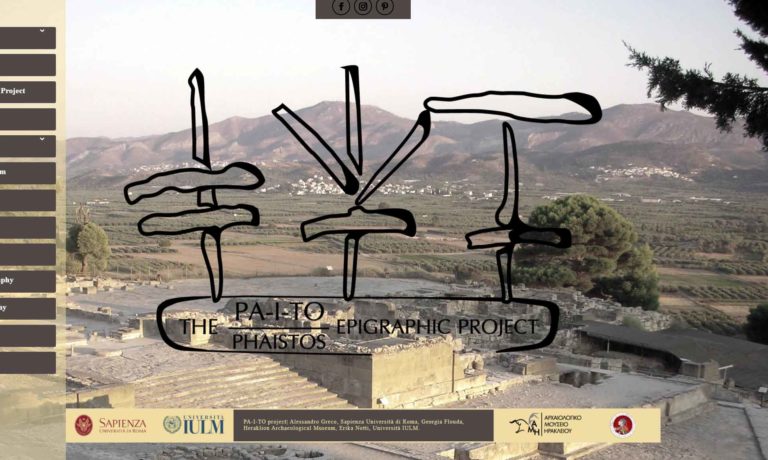È con grande piacere che siamo onorati di condividere con voi il frutto di una grande fatica del Phaistos/pa-i-to Project. Oggi inauguriamo ufficialmente il sito web www.paitoproject.it dove, nel corso delle settimane che seguiranno, caricheremo una serie di riproduzioni digitali delle tavolette in Lineare B provenienti dal palazzo di Knossos, che parlano proprio della nostra Festòs, che in miceneo si trascriveva pa-i-to.
The Linear B pa-i-to Epigraphic Project è un progetto epigrafico e filologico finalizzato allo studio di Festòs in epoca micenea attraverso l’analisi di questi documenti straordinari che sono le tavolette in Lineare B; per fare questo, nel corso degli anni l’equipe diretta da Alessandro Greco (professore associato presso l’Università di Roma, La Sapienza) e Georgia Flouda (direttrice del Dipartimento di Antichità preistoriche e minoiche del Museo Archeologico di Heraklion), si è recata al museo di Heraklion, dove la gentile collaborazione della sua direttrice Stella Manadalaki e lo staff del museo hanno permesso una serie di campagne di acquisizione digitale della documentazione attraverso le tecnologie dell’RTI e del 3D.
Il progetto è stato scientificamente ed economicamente condiviso da un progetto correlato (The ‘From Tablet to Tablet’ Project. Exploring the Practical Applications of Imaging Techniques in Epigraphy and the Cultural Heritage) diretto da Erika Notti, Mario Negri e Giovanna Rocca della Università IULM di Milano, Dipartimento di Studi umanistici.
Il sito verrà progressivamente implementato fino alla completa pubblicazione di tutte le 94 tavolette in Lineare B che recano il nome di Festòs; inoltre, saremo presto in grado di pubblicare anche altre collezioni di documenti, tra cui tavolette e cretule in Lineare A, rinvenute ad Haghia Triada e facenti parte della collezione del Museo Pigorini, nonché di documenti provenienti un più da lontano, ossia dalla Mesopotamia (con la collezione del “Museo Barracco” di Roma).
Pubblicheremo questi interessanti documenti di settimana in settimana, ovviamente senza mancare di tenervi informati sulle nostre pagine social!
Oggi, abbiamo pensato di darvi un assaggio di quanto descritto con un piccolo frammento che reca il nome del nostro bel sito: pa-i-to.
Andate a vederlo!
Man a mano che le pubblicheremo non mancheremo di tenervi informati!
We’re really excited to share with you the results of our efforts in the Phaistos/pa-i-to Project. This is the official announcement of today’s launch of the website www.paitoproject.it, where you’ll be able to find the digital reproductions of a selection of Mycenaean tablets dealing with our beloved Phaistos – pa-i-to in Mycenaean script – as it is gradually updated over the coming weeks.
The Linear B pa-i-to Epigraphic Project is an epigraphic and philological programme which sets out to analyse the fascinating Linear B documents concerning Phaistos.
Our team, directed by Alessandro Greco (associate professor at the University of Rome, La Sapienza) and Georgia Flouda (director of the Department of Prehistoric and Minoan Antiquities of the Heraklion Archaeological Museum), has conducted several missions to the Heraklion museum over the years in the course of our research. Here, with the valuable collaboration of the director of the Museum, Stella Manadalaki, and her staff, we were able to complete the digital acquisition of the documents using RTI (Reflectance Transformation Imaging) and 3D Laser Scanning techniques.
This project was backed both financially and scientifically by the Department of Humanities of IULM University (Milan), under the aegis of the programme “The ‘From Tablet to Tablet’ Project. Exploring the Practical Applications of Imaging Techniques in Epigraphy and the Cultural Heritage” coordinated by Erika Notti, Giovanna Rocca and Mario Negri.
Updating will continue a little at a time, until all of the 94 Linear B tablets bearing the name of Phaistos are finally published on the site.
We aim to publish other collections of documents as well, ranging from the Linear A tablets and cretulae discovered at Ayia Triada and currently housed at the Pigorini Museum,j to written evidence from more distant regions such as Mesopotamia, taken from the collection of the “Barracco Museum” in Rome.
These intriguing documents will appear on a weekly basis – we’ll keep you posted on our social pages!
As a starter today, here’s a glimpse of a small fragment bearing the name which our fantastic website was named after: pa-i-to.
Check it out!
We’ll keep you posted on updates as they come in!

